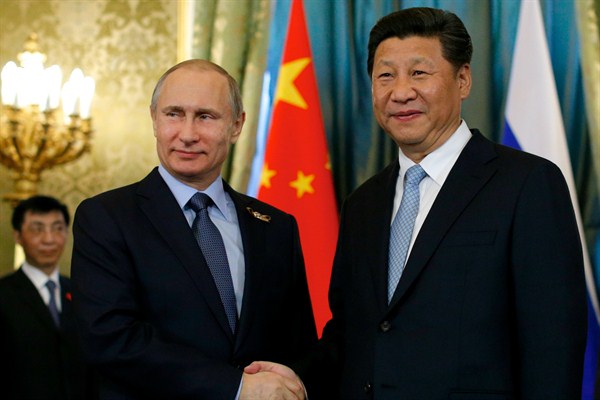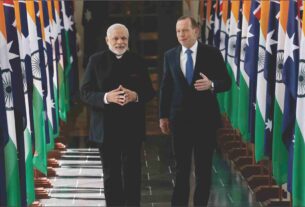China’s focus on Russian Far East can be a long term threat
Russia is fast tracking a Chinese proposal to pump water from Lake Baikal, a UNESCO World Heritage site, and carry it across two borders to help alleviate water shortages which seem to be a problem solver but some Russian environmentalists have started opposing this plan.
Now Russia is not only confused but wants to go slow on the plan as the Lake is unhealthy in terms of massive climate change impact and too much Chinese focus on Russian resources could be bad as both nations have their legacy of problems in history.
Russian Far East region is receiving too much Chinese attention in mining and other population related issues which is making Russia nervous about future Chinese plans.
The Lake Baikal holds roughly 20 per cent of the world’s total unfrozen freshwater which as per Chinese plans can be carried to northwestern China and Mongolia, helping agriculture as well as thirsty people and industries along the way. For Russia, selling this water could strengthen the country’s economic presence in China and Mongolia.
For last five years, Chinese authorities in Lanzhou, the capital of Gansu Province in northwestern China, are now considering a 1,000km pipeline that would transport the water and China has granted 27 million US dollar for laying down the project.
But the lake itself appears to be in trouble. Draining much of what is also known as “the Pearl of Siberia” would inevitably further damage the treasured ecosystems in and around the lake.
Already, increasing throngs of Chinese tourists visiting Lake Baikal-and how they treat the environment — has become a major issue.
Conservation groups in Russia and elsewhere have been saying the lake’s water level has been receding and that it is becoming contaminated.
Already, these alarm bells have the Russian government thinking it might have to abort a plan to turn the lake into an international resort.
Russia has high expectations for Chinese cash, indeed, Alexander Tkachev, Russia’s minister of agriculture, last year proposed a plan to deliver water from Siberia’s Altai Republic to China’s Xinjiang Uighur Autonomous Region. But if the Lake Baikal plan goes through, it could spark massive protests among nearby residents.
On the top of it, Russia is rethinking on various areas of cooperation with China after learning about the new adventurism of China into Russian resources and territory. Russia is realizing that giving China a free hand in Siberian region and its Far east could be disaster for Moscow in future.
Most Russian military experts feel that China is moving too fast and Beijing can easily alter its commitments and claims due to its hyper ambitions.
Russia is seldom thought of as an Asia-Pacific country. Yet it is one-thanks to its Far East. The Russian Far East is a huge area of northeastern Eurasia stretching from Lake Baikal to the Pacific Ocean.
This is allowing Russia direct access to the Asia-Pacific region, the RFE (Russian Far East) makes it a truly transcontinental nation, the only other such a country being the US.
The RFE contains all kinds of natural treasures-oil and natural gas, iron ore and copper, diamonds and gold, pristine fresh water (Lake Baikal alone has more than 21 per cent of the world’s unfrozen surface freshwater), timber and fish stocks (for example, the Sea of Okhotsk is one of the most biologically productive areas of the world ocean).
The entire vastness of the RFE contains just over 6 million residents. Being remote from, and having tenuous transportation links to, the country’s European core, suffering from underdevelopment and the lack of infrastructure, the RFE is a source of constant concern for Moscow.
Ever since Russia acquired these territories, there have been recurring worries that they are at the risk of being lost due to external aggression, foreign encroachment, internal separatism-or a combination of the three.
The RFE has historically had an ambivalent relationship with its giant neighbor, China. It is seen as an indispensable economic partner.
Yet China is simultaneously a source of threat. After all, the southern part of what is now the Russian Far East used to be underthe Qing’s nominal sovereignty until the second half of the 19th century.
Despite the fact that, at the official level, the border issue between Moscow and Beijing is fully settled by legal treaties, there are lingering concerns in Russia that China might in the future reclaim the land.
This is not helped by the well-known sentiments of many in China who still see the 19th-century border treaties with the Russian Empire as “unfair” and count them as part of “the century of humiliation.”
For the time being, Moscow and Beijing are “strategic partners,” with the relationship increasingly resembling a quasi-alliance. One major reason China needs a strong bond with Russia lies in the Russian Far East.
Beijing wants to have a secure and peaceful northern border with Russia, so that it can concentrate its military resources and planning on other strategic theaters, above all in the Western Pacific.
The memories of confrontation with the Soviet Union, when China had to expend enormous efforts on reinforcing its frontiers with a hostile neighbor to the north, have not yet faded away.
China’s voracious economy needs the RFE’s natural resources, which makes sense not only economically but also, at least as much, strategically.
There are signs that China is beginning to see Eastern Russia as an important “strategic rear area”, a proximate overland supplier of a range of vital primary commodities.
This is directly related to China’s intensifying contest with the US for primacy in the Asia-Pacific.
Beijing is increasingly worried that, if this rivalry comes to a head, Washington may use its trump card-launching a naval blockade of the sea lanes through which China receives most of its imported primary products.
The growing dependence on imported raw materials and rising concerns about the fraught relations with the US, and it’s Indo-Pacific allies, seem to have resulted in Beijing’s attaching much greater priority to the RFE than was the case five or 10 years ago.
Until recently, the Chinese economic presence in the RFE was quite limited. The number of Chinese migrants in the RFE has also been modest-no more than 300,000-most of them as sojourners rather than permanent residents.
There are, however, indications that China’s footprint in the RFE is about to grow. China’s interest in the RFE has coincided with Moscow’s hour of need.
Although just a few years ago the Kremlin was reluctant to allow the Chinese direct access to the most valuable industries of the Far East, it had to change its mind when faced with Western isolation over Ukraine and now having few alternatives but China.
Moving, or rather being pushed, closer to China amidst confrontation with the West, Moscow has lifted formal and informal restrictions on Chinese investments that existed hitherto and begun to actively court Chinese capitals.
The main thrust has been in the hydrocarbon sector, epitomized by the gargantuan 400 billion, 30-year contract signed in May 2014 by Gazprom and CNPC to supply the RFE’s gas to China.
In other landmark developments, focused on eastern Russia, Moscow agreed to sell Chinese companies stakes in the country’s most lucrative oil field and the world’s third biggest copper field.
Recent Russo-Chinese deals in the RFE have not been limited to resource-extraction industries.
In 2014, Russian and Chinese government-affiliated companies announcedthey would jointly develop Zarubino port, strategically located in the south of the RFE at the junction of Russian, North Korean and Chinese borders.
The port at Zarubino will give China direct access to the Sea of Japan, which it has long coveted.
The port, with the expected throughput capacity of 100 million tons, will mostly handle Chinese cargoes.
Chinese companies have also become the principal investors in a large-scale integratedcasino resort near Vladivostok, which is slated to open in 2015 and aims to service mostly visitors from China.
Speaking at Saint Petersburg’s Economic Forum in May 2014, Chinese Vice President Li Yuanchao called for the linking up of the RFE with northeast China in order to “turn the two into a big market-a new economic bloc in Asia.“
In dealing with the RFE, Beijing can deploy its giant state-owned corporations, which boast some of the deepest pockets in the world and are driven by the government’s strategic calculations as much as by purely commercial considerations.
Compared to Western companies with shareholder responsibility, they can make hefty investments with much longer planning horizons and without expecting short-term returns.
This gives China a significant advantage in the RFE, where business projects often require massive financial outlays, are accompanied with significant risks, and do not promise quick profits.
The RFE is one piece in China’s long-term geopolitical game aimed at creating zones of influence along its continental frontiers in Eurasia.
Two other major areas, where Beijing pursues similar goals of securing its borders, getting preferential access to rich natural resources, and probably gaining there a degree of political control in the future, are continental South-East Asia and Central Asia.
Incidentally, large parts of these regions, like the RFE, were in the past under China’s sovereignty or suzerainty.
Another common feature of Beijing’s policy towards the “rear areas” is to bind them up with the neighboring regions of China: southwestern China (especially Yunnan province) for South-East Asia, western China (Xinjiang) for Central Asia, and northeastern China (Heilongjiang) for the RFE.
Despite its seeming enthusiasm about the growing intimacy with Beijing, Moscow is aware of the costs and risks of embracing China.
China’s privileged access to the RFE could lead to Chinese economic dominion which would not only exclude other foreign competitors but can also begin to squeeze Russian companies out of the RFE.
Economic sinicization may, sooner or later, set the stage for the erosion of sovereign control.
There is a probability that China’s exclusive economic penetration of the RFE would eventually be followed by a rising degree of geopolitical control, ultimately jeopardizing Russian sovereignty and threatening to turn the RFE into not just a raw material appendix.
But also a military-strategic base for China can be worked out in the North Pacific, especially if Moscow enters a full-fledged alliance with Beijing.
The RFE could become exactly what some Chinese prefer to call it-“Outer Manchuria,” a territory where Russian sovereignty is getting increasingly tenuous and where matters are decided in Beijing and Harbin rather than Moscow or Vladivostok.
Some security experts in Russia even discuss a scenario in which China moves to annex the RFE by a surprise attack.
This is not to say that such an invasion is imminent or likely. However, it cannot be ruled out, if Russia becomes too weak-particularly if it descends into chaos due to a severe political or economic crisis.
If China tries to grab the RFE, this may draw in other players would the US pre-emptively occupy Chukotka, Magadan, Kamchatka and the Arctic shore of Yakutia before Chinese enter these territories? And would Japan, in turn, take control of Sakhalin and the Kuril Islands?




